Demographics - Create and Manage Demographic Fields in Your Database
Demographic BuilderQuestions are all the data fields/questions in your database. Questions may be used on forms, or they may exist only in the database for backend use, e.g. data imports, manual data entry, etc. This lesson describes how to create and manage questions.
Please refer to Quick Start Guide- Forms for information on basic concepts and rules relating to forms.
ORDER OF DEMOGRAPHICS
The order that questions appear in the Demographic Builder is the order that they'll appear in User Detail and the Add New User windows.
In User Detail the first ten demographic questions and responses will appear by default, and to see the remaining questions/responses you must click "More Information >>". So, for example, if you want to see First Name, Last Name, Email, Title, Company Name, Company Address, Address2, City, State/Province, Zip/Postal Code by default in the User Demographic window, put your questions in that order in the Question Builder. The same applies if you want to have certain questions appear first in the Add New User window (for quicker manual entry).
See directions below on how to change the order of questions.
First, click on the "move" icon to the left of the question ID number.

Next, drag and drop the question into its new location. It's that simple.

See below how First Name was moved to appear after Last Name.

OPENING THE DEMOGRAPHIC BUILDER
Select INVENTORY from the main menu.

Select DEMOGRAPHICS from the sub-menu.
This will open the Question Builder where you will see a list of existing questions and the options to Create/Update Download Template* and to Create Question (See below.)

*Create/Update Download templat allows you to create and save templates of demographic fields to include when downloading a list. These templates may be selected at the time of download in the List Wizard. Many times the same demographic fields are needed for multiple lists, and this will enable a user to simply select a previously created template rather than having to go through and select each field for each list. This functionality is available in version 11.6 and later.
To quickly find a question, use the Search functionality at the top of the page to search by question name or id.
HOW TO CREATE A DEMOGRAPHIC QUESTION / DATABASE FIELD
Questions are all the data fields/questions in your database. Questions may appear on forms, or they may exist only in the database for administrative use, e.g. data imports, manual data entry, etc.
Because these "questions" are the actual data fields, they are a part of a pool of data fields/questions that are shared among ALL forms. If you change or delete a question, the change/deletion will change/delete that data field in the database and the question on ALL forms that use the question.
There are two types of questions: standard (generic questions that are part of ONEcount--e.g first name, last name, email) and user-created. User-created questions are those that you create and are specific to your database and forms, i.e. the user information you wish to include in your database and gather from your forms. Many of your questions will be user-created. It is not recommended to delete standard questions from the database.
Click "Create Question"

This will open a pop-up window, as shown below, where you enter the question text, response type, question alias,eport header, Question Tag, and Lookup Question. More detail on this follows.
"Question Text" - Enter the question text to be displayed on a form on the front end.
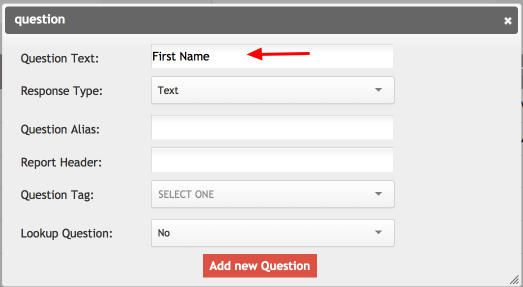
The Question Text is the text that a visitor would see on a form on your website.
As described above, there are some standard questions that can be used in a form. It is best to use existing questions if they match what you want the question to be. (See warning below.)
Warning: Remember that any changes to the Question Text will apply to the data field in your database and apply to ALL forms that use that question, even those previously created.
"Response Type" - Select the ResponseType for each question from the drop-down menu. See information below for further explanation.
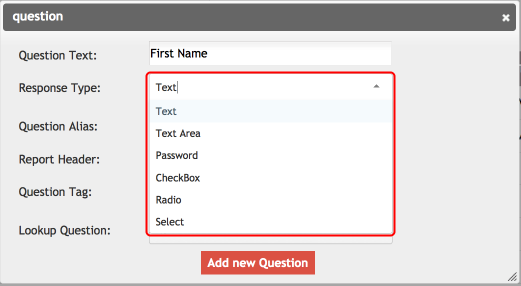
Response Type defines the type of answer expected for the question; e.g., it makes sense to allow a user to select a state from a pull down instead of asking them to fill in a text box. This ensures the ONEcount system has uniform data in the database.
The response type can be text field, text area, password, checkbox, radio button, select.
The different types of response types are as follows:
Text Field, Text Area, and Password Field (Open Ended)
text field: the user must type in a response (e.g. first name, last name)
text area: same as text field, except allows more characters
password field: text entered is not shown--converted to *
- Radio Button and Select (Single Select - user can select only one response)*
radio button - user clicks on round button to select one response (e.g. male / female, yes/no/maybe)
select - user selects one response from a drop-down menu of choices
Checkbox List (Multi Select)*
user can click on multiple check boxes to select multiple responses from a list of choices
Note: The system will automatically create values for Checkbox List-type responses. If you will be importing data to this field, these values must be replaced in the import file.
Warning: Remember that any changes to Response Type will apply to the question/data field in your database and to ALL forms that use that question, even those previously created.
DON'T change a select- or radio-button type question to a text or checkbox-type question. Select- and radio-button type questions are created to ensure consistency in response values, and changing to a text-type question allows for inconsistent responses. For example, Country is a select-type question with certain display text and database values. Changing the question to, e.g., to a text-type question would allow front-end users to enter any text as a response. Using "United States" as an example, users could enter US, USA, U.S.A., United States of America, Unites States (notice the misspelling), Estados Unidos, etc. To pull a list, generate a report, create a targeting persona, you would have to determine and then include every possible variation of United States to do so. By keeping it as a select-type question, data is uniform, and lists, reports, and personas can be created consistently and accurately.
It is best not change a text/radio button/select-type question to a checkbox-type question. Because the system assigns values to checkbox-type questions and stores them in a different manner than other question types, if users' profiles are not updated with the new value for the checkbox-type question, the previously assigned values won't match the new values created by the system and can't be translated to the new values. As a result, User Demographics and Demographic Activity will show a blank for the response to that question and the List Wizard won't be able to generate a list based on that demographic. This will also affect pulling analytics based on that demographic question from Web Analytics and creating a target segment in the Persona Manager. (Remember, if user profiles aren't updated to new values, the system won't be able to translate the previous values to the changed values because of the different way they are stored within the system.)
When selecting to "View" a generated list in the List Wizard (which allows you to run a product or demographic report and immediately view it), you can only select demographic questions with Radio Button or Select-type responses for rows and columns in the reports. Text Field, Text Area, Password Field, and Checkbox List type responses cannot be used.
For Checkbox, Radio, and Select-type questions the display will change, allowing you to enter the Display Text (1), and for Radio and Select-type questions you can enter the value (2) for each possible response, as shown below.
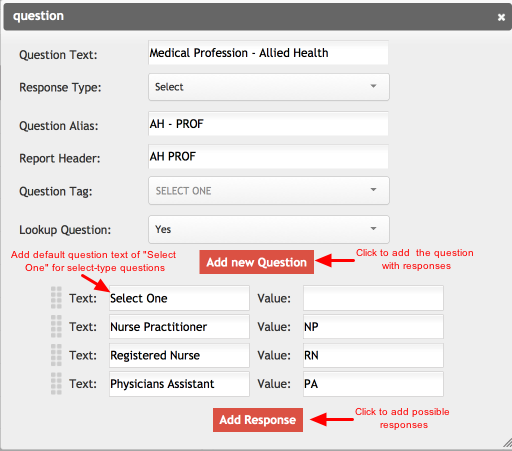
(1) Display Text is the text that a visitor will see on the form.
(2) Value is the value you want assigned in the ONEcount database for that response. Values can be numeric or alphabetic (e.g. in a Yes/No question Display Text “Yes” value could = 1 or Yes, and Display Text “No” value could = 2 or No.) .
TAKE NOTE:
The system will automatically create values for Checkbox-type responses. The "Value" field is locked, so you cannot enter your own values. When you save the question, the system-generated values will be added. If you will be importing data to this field, these values must be replaced in the import file.
For select-type questions, be sure to create a default answer as the first response, such as “Select One” If this is not set, any user who doesn't select an answer for the question will automatically be assigned the first value, which could be incorrect.
Do NOT use comma separated values or special characters as a value in select- and radio button-type responses. This will cause an error when displaying reports, forms, and saving user data.
Do not create any display text or value longer than 255 characters. The full text will not be saved.
The order of responses can be changed in checkbox list, select, and radio button types of responses by clicking on the gray icon to the left of "Text:" and dragging the row to the desired position.
Any blank responses will automatically be deleted upon pressing "Add New Question".
Text and Values may be edited by clicking in the entry field.
Warning: Remember that any changes to Response Value will apply to the data field in your database and to ALL forms that use that question, even those previously created.
"Question Alias" - Enter a Question Alias, if needed.
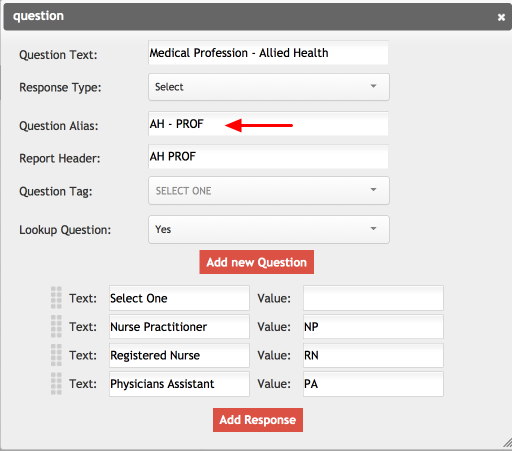
Question Alias is used for identifying a question for a specific form. For example, you may need to create a two (or more) identical questions with different response options because the question has different possible responses or you may need to create two (or more) questions with very similar Question Text. To avoid confusion among similar questions, enter an alias for the question. Or, you may want an alias of ALL for questions that can be used across all forms.
For example, if you have different publications and/or products to offer – one for, say, medical doctors and another for allied health professionals - and both forms have the Question Text “Medical Profession", the response options may need to be slightly different to reflect the different types of titles for the different verticals. In such a case, you can create a "Medical Profession" question, then duplicate it and create an alias for the questions so you can identify them, e.g. abbreviated name of the publication/product or "AH - PROF” for the question with Allied Health responses and “DOC - PROF” for other.
In the screenshot above, the Question Alias "AH - PROF" identifies that particluar question and it's responses should be used for forms for Allied Health Professionals. Note "Select One" is the first possible response.
Warning: Remember that any changes to the Question Alias will apply to ALL forms that use that question, even those previously created.
"Report Header" - Enter text to be displayed in reports.
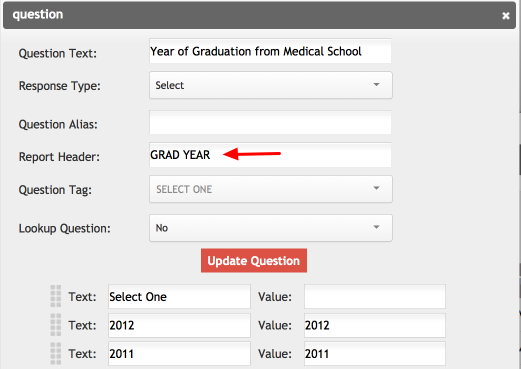
When a list is downloaded, the Report Header is the text that will appear in the report.
If no text is entered in this field when creating the form, the complete Question Text will appear in the report. It is best to include a Report Header if the question text is more than several words.
In the screenshot above, GRAD YEAR will appear as the column header in the list/report rather than "Year of Graduation from Medical Schoool?"
"Question Tag" – Select Question/Field to Tag (v. 11.6 and later)
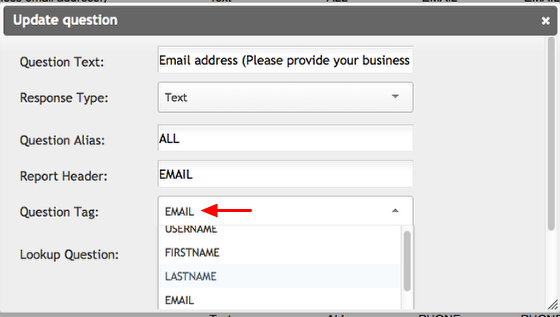
Question Tags are used in conjunction with progressive lookup, social media login, forgot password, and smartlinks. They are used to identify and map questions in ONEcount for purposes such as checking for duplicate/existing email addresses when completing a form, checking username and password, and for identifying the correct field in which to put data coming into the ONEcount system from outside sources such as social media login.
QUESTION TAG CONFIGURATION SHOULD BE DONE UPON QUESTION CREATION. IF REQUIRED QUESTIONS, E.G. EMAIL, AREN'T CONFIGURED WITH A QUESTION TAG, PROGRESSIVE LOOKUP AND OTHER FEATURES MAY NOT WORK PROPERLY.
The Email question MUST be set with a Question Tag so that the system will know that is the field to check for an existing email when a user enters his/her email address in a form. If the email is identified, the user will be presented with a challenge question. When the question is answered correctly the user will automatically be logged in and the form auto-populated with the user's information. (See Progressive Lookup for more information on how ONEcount's progressive lookup feature works.)
The Question Tag for Phone comes into account when progressive lookup needs to send a code to a mobile number. Other question tags like city, state, birthday, gender, etc. (the values that can be pulled up from social login) are used in social login to auto-populate those question fields in a form.
When a question is tagged, it says to the system, "This is the question ID for email" or "This is the question ID for username" or "This is the question ID for Last Name" so that ONEcount knows to match email or phone information with the correct question/field when input by a user or when being pushed to ONEcount from social media login.
*In Version 11.6 and prior, there are mappings for these questions in the Configuration Manager. However, the questions should also be tagged in the Question Builder. Questions/fields that should be tagged are those that will be used for checking for duplicate/existing email and phone data, Username and Password for login and duplicate checking, and fields that will be pulled into ONEcount upon logging into ONEcount va social media, such as first name, last name, city, state, zip, gender, etc.
- In post-Verion 11.6, the mappings will no longer be in the Configuration Manager and Question Tags will be the only mechanism to map questions. Question Tags will be pre-set for standard demographic questions that come with the ONEcount system.
"Lookup Question" – Select Yes or No (v. 11.6 and later)
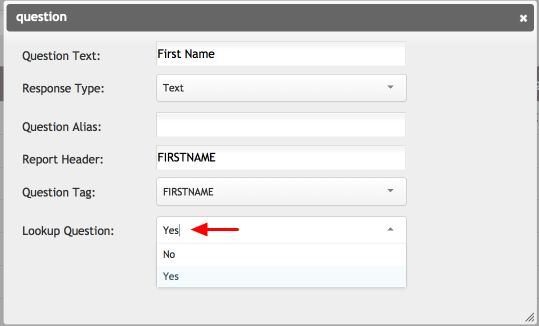
Lookup Questions are used in conjunction with ONEcount's progressive lookup feature.
The default is "No", meaning that the question will not be used as a challenge question for progessive lookup on forms.
Selecting "Yes" means that the question will be used as a challenge question for progressive lookup on forms.
See Progressive Lookup documentation for more detail on progressive lookup functionality.
If you set several lookup questions there is more probability that the system will present the user a challenge question instead of sending a verification code (see Progressive Lookup documentation).
Challenge questions will only appear if the question value is not empty; and they should be questions that are not being answered in the form. More selected lookup/challenge questions means more of a chance that a user has a response in the database to one of them and will be able to answer rather than requiring a verification code.
Once Question Text, Response Type, Question Alias, Report Header, Question Tag, Lookup Question, and possible responses and values are completed, click "Add New Question" to save the question.
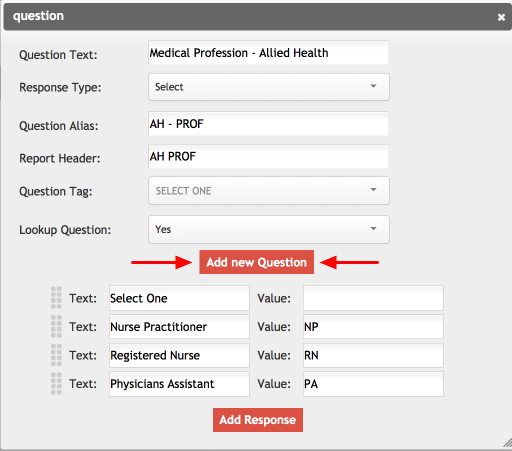
The new question will be assigned a Question ID and appear at the top of the list of questions. (See below.)

You can change question order by clicking on the icon to the left of the ID number and dragging the question to the desired location in the list.
The order of questions in the Question Builder is the order that they will appear in User Detail and when adding a new user.
HOW TO CREATE A DOWNLOAD TEMPLATE (v. 11.6 and later)
"Create/Update Download Template" allows you to create and/or edit templates used for repeated downloads that include the same demographic fields each time. Templates can then be selected when you download a report/file.
Click on "Create/Update Download Tempate".

This will open the "Manage Download" Template window where you'll see a list of existing templates, as shown below.
Click "Create Template".

This will open the "Add/Update Download list Template" pop-up window, as shown below.
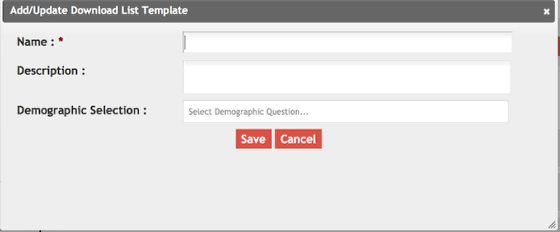
Give the template a name, description, and select demographic fields you want to include in the template.
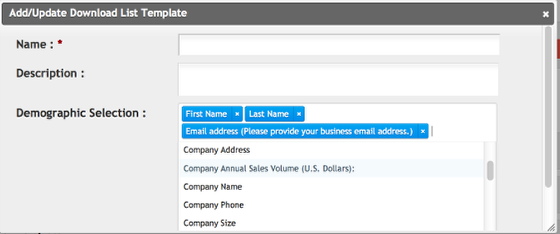
When finished selecting the demographic fields for the template, click anywhere outside of the Demographic Selection drop-down list and click "Save".
To cancel the operation, click "Cancel".
HOW TO EDIT A DOWNLOAD TEMPLATE
Click on "Create/Update Download Tempate".

This will open the "Manage Download" Template window where you'll see a list of existing templates, as shown below.
Note: to quickly locate a template, use the Search functionality.
Click the "expand" icon to see a list of demographic fields included in a template.

Click the "edit" icon.

This will open the "Add/Update Download List Template" pop-up window as shown below.
Add/remove demographic fields and/or change Name and Description.
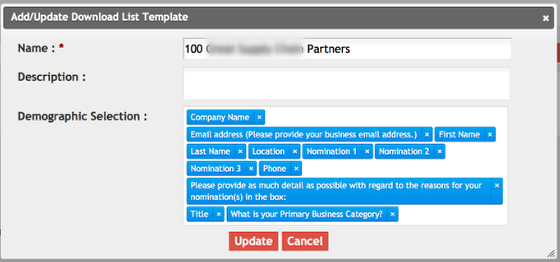
To remove a question/field, click on the "x" to the right of the question.
To add a question/field, click anywhere in the Demographic Selection field to display a drop-down list of remaining demographic questions.
When done, click "Update".
To cancel the operation, click "Cancel".
HOW TO MANAGE QUESTIONS
Icons in the "Operation"" column are used to edit, delete, and copy questions.

To edit a question, click on the Edit icon.

This will open the "Update Question" window where all relevant fields for the question type may be edited. (See below.)
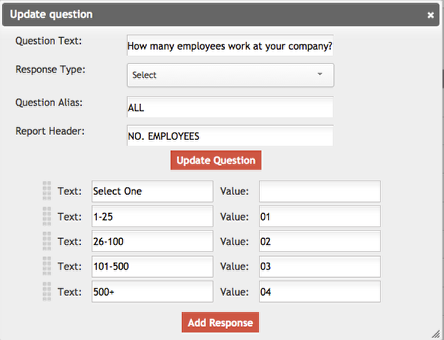
Important Note:
It is best not change a text/radio button/select-type question to a checkbox-type question. Because the system assigns values to checkbox-type questions and stores them in a different manner than other question types, if users profiled are not updated with a value for the checkbox-type question, the previously assigned values won't match the new values created by the system and can't be translated to the new values. As a result, User Demographics and Demographic Activity will show a blank for the response to that question and the List Wizard won't be able to generate a list based on that demographic. This will also affect pulling analytics based on that demographic question from Web Analytics and creating a target segment in the Persona Manager. (Remember, if user profiles aren't updated to new values, the system won't be able to translate the previous values to the changed values because of the different way they are stored within the system.)
To delete a question, click on the Delete icon.

NOTES:
Because these "questions" are the actual data fields, they are a part of a pool of data fields/questions that are shared among ALL forms. If you change or delete a question, the change/deletion will change/delete that data field in the database and the question on ALL forms that use the question.
DO NOT DELETE ANY STANDARD QUESTIONS (THOSE QUESTIONS THAT CAME PRE-INSTALLED WITH ONECOUNT – QUESTION #s 1-14).
USE DELETE WITH CAUTION. IF YOU DELETE A QUESTION IT WILL BE DELETED FROM ALL FORMS THAT ARE USING IT. IF USERS HAVE RESPONDED TO A DELETED QUESTION, THE DATA WILL REMAIN IN THE DATABASE, BUT YOU WON'T BE ABLE TO RETRIEVE IT (E.G. USING THE LIST WIZARD TO RUN A LIST BY DEMOGRAPHIC).

Select on the pop-up confirmation either "Cancel" to cancel the deletion or "OK" to proceed with the deletion.
Remember that deleting a question will remove it from the database and from ALL forms it appears on.
To copy a question, click on the Copy icon.

This will make a copy of the question, including Text/Type/Alias/Report Header and all response text and response values.
The new question will have the same question text as the old, with "_Copy" appended at the end, and it will appear at the bottom of the question list. In the screenshot below, the question "How many employees work at your company?" was copied.

Once the question is copied, you can rename and edit it just as you would any other question.
Note: If only adding or removing responses to a question, don't copy/create a new question.
Search all Documentation:
Unknown macro: livesearch. Click on this message for details.
The [livesearch] macro is not in the list of registered macros. Verify the spelling or contact your administrator.
Search INVENTORY Documentation:
Unknown macro: pagetreesearch. Click on this message for details.
The [pagetreesearch] macro is not in the list of registered macros. Verify the spelling or contact your administrator.
More INVENTORY Documentation:
Click here to expand...
Quick Start Guide - Products & Resources
Products - How to Create a Product Part 1: Create, Name, Attach Forms
Products - How to Create a Product Part 2: Product Terms
Products - How to Create a Product Part 3: Attach/Remove/Create a Resource
Products - How to Manage Products
Quick Start Guide - Questions and Forms
Question Builder - Create and Manage Questions
Forms - How to Enable/Disable Lookup/Login Page
Brand - How to Create and Manage Brands
Resources - How to Create a Resource
Resources - How to Manage Resources
Promo Codes - How to Create and Manage Promo Codes
